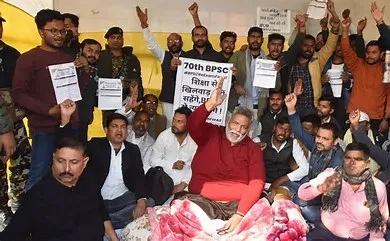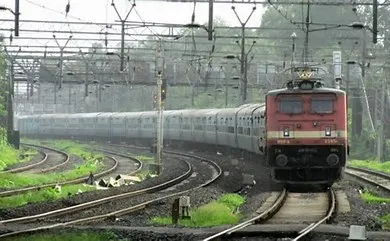Economic empowerment is the capacity of women and men to participate in, contribute to and benefit from growth processes in ways that recognise the value of their contributions, respect their dignity and make it possible to negotiate a fairer distribution of the benefits of growth.
However, the presence of gender disparity in any economy requires attention and corrective measures for achieving the overall development in terms of “society”. Women’s economic empowerment is central to realizing women’s rights and gender equality.
The Worker Population Ratio (WPR) is an indicator used to assess the country’s employment situation. The ratio informs us about the proportion of a country’s population that actively contributes to the production of goods and services.
Worker Population Ratio (WPR) in r/o age group – all ages: In Delhi, Worker Population Ratio (WPR) was 51.9% in 2017-18 for male population as compared to 9.9% for female population while in 2021-22, it was 54.5% for male population & 8.8% for female population, which shows a slight increase for male population but a little decrease in percentage for female population.
Whereas, at the India level, it was 52.1% in 2017-18 for the male population and 16.5% for the female population while during 2021-22, it was 54.8% for the male population & 24.0% for the female population, which shows the increasing trend both in male & female population.
Worker Population Ratio (WPR) in r/o age group – 15 years and above: For the age group 15 years and above, Worker Population Ratio (WPR) was 68.1% for the male population as compared to 12.8% for the female population in 2017-18, and it was 68.9% for male population & 11.5% for female population in 2021-22 in Delhi, whereas at all India level, it was 71.2% for male population and 22.0% for female population in 2017-18 and it was 73.8% for male population & 31.7% for female population in 2021-22.
It is visible from the data that the situation of women is much lower as compared to men. This indicates that the number of working women is far less in comparison to men which could be due to various socio-economic factors.
The Labour Force Participation Rate (LFPR) indicates the percentage of all people of working age who are employed or are seeking work. The rate excludes individuals who are neither working nor looking for work like students, pensioners, housewives, etc.
Labour Force Participation Rate (LFPR) in r/o age group – all ages: In Delhi, Labour Force Participation Rate (LFPR) was 57.3% for male population as compared to 11.2% for female population in 2017-18, and it was 57.5% for male population & 9.4% for female population in 2021-22, whereas in 2017-18 at all India level, it was 55.5% for male population and 17.5% for female population and in 2021-22, it was 57.3% for male population & 24.8% for female population.
Labour Force Participation Rate (LFPR) in r/o age group – 15 years and above: For the age group 15 years and above, Labour Force Participation Rate (LFPR) was 75.0% for the male population as compared to 14.3% for the female population in 2017-18 and it was 72.6% for male population & 12.2% for the female population in 2021-22 in Delhi.
It shows that the Labour Force Participation Rate has decreased in 2021-22 as compared to 2017-18 in Delhi. However, in 2017-18 at the India level, it was 75.8% for the male population and 23.3% for the female population and in 2021-22, it was 77.2% for the male population & 32.8% for the female population.
LFPR of the female population is far behind that of the male population in the age group of 15 years and above (72.6% for males and 12.2% for females in 2021-22) and the disparity has remained almost the same over the years. Such low participation of women as compared to men in Delhi’s labour force may be due to social factors.
As per the broad employment status in Delhi in 2017-18, out of the total male workers, 34.5% of male workers were engaged in the self-employed category, 59.2% in the regular wage/salaried employee category and 6.3% in the casual labour category.
Similarly, out of the total female workers, 21.8% of female workers were engaged in the self-employed category, 76.6% in the regular wage/salaried employee category and 1.7% in the casual labour category. In 2021-22, 33.1 % of male workers were engaged in the self-employed category, 63.3% in the regular wage/salaried employee category and 3.5% in the casual labour category.
However, out of the total female workers, only 17.0% were engaged in the self-employed category, 83.0% in the regular wage/salaried employee category and 0.0% in the casual labour category. This shows a switch from casual labour to regular wage/salaried category by the women workers in 2021-22.
Out of total female workers, a greater proportion of female workers (65.02%) were engaged in ‘other services’ in 2017-18 and 59.74% in 2021-22 in Delhi. However, out of the total male workers, a major proportion of male workers were engaged in ‘trade, hotel & restaurant’ (26.78%) in 2017-18 and 29.77% in 2021- 22 followed by ‘manufacturing’ & ‘other services’.
The unemployment rate is a useful measure of the underutilisation of the labour supply. It is by definition those persons who want to work but are not doing so, even though they are available for employment and actively seeking work, thus reflecting the inability of an economy to generate suitable employment.
Unemployment Rate (UR) in r/o age group – all ages: In Delhi, the Unemployment Rate (UR) was 9.4% for male population as compared to 11.4% for female population in 2017-18 and in 2021-22, it was 5.1% for male population & 6.0% for female population, whereas in 2017-18 at all India level, the Unemployment Rate was 6.2% for male population and 5.7% for female population and in 2021- 22, it was 4.4% for male population & 3.3% for female population. The figures show that the Unemployment Rate has decreased in 2021-22 for both the male and female population.
Unemployment Rate (UR) in r/o age group – 15 years and above: For the age group-15 years and above, the Unemployment Rate (UR) was 9.2% for male population as compared to 10.7% for female population in 2017-18 and it was 5.1% for male population & 6.0% for female population in 2021-22 in Delhi, whereas, at all India level, it was 6.1% for male population and 5.6% for female population in 2017-18 and it was 4.4% for male population & 3.3% for female population in 2021-22.
Average Wage Earning received per day by Casual Labourers in work other than Public works in different quarters from July to June for the years 2017-18, 2018-19, 2019-20, 2020-21 & 2021-22 in Delhi and at the national level shows that out of the total female population, 89.42% females came under the category of ‘non-workers’.
The gender-wise employment under Agriculture, Non-Agriculture (Other than Services comprising of mining & quarrying, manufacturing, electricity, gas, steam, water supply, sewerage, waste management and construction activities) & Non-Agriculture (Services) establishments in Delhi.
Under the ‘Agricultural Activities’ sector, 80.63% of males and only 19.37% of females were found to be employed in agricultural establishments. Further, under the ‘Non-Agriculture Establishments (Other than Services comprising of mining & quarrying, manufacturing, electricity, gas, steam, water supply, sewerage, waste management and construction activities)’ sector, the highest numbers of males 91.58% were engaged.
The female participation under this category was only 8.42%. However, under the ‘Non-Agriculture establishments (Services)’ sector, 85.33% of males and 14.67% of females were engaged. In totality, a major difference was found in the employment of men 87.52% and women 12.48% under the 6th Economic Census of Delhi (2013).
While economic empowerment is crucial for overall societal development, the statistics reveal significant gaps between men and women in terms of workforce participation and employment types.
The Worker Population Ratio (WPR) and Labour Force Participation Rate (LFPR) indicate a substantial gender divide, with fewer women actively contributing to the workforce, especially in the age group of 15 years and above. The gender-wise employment distribution in different sectors shows a significant underrepresentation of women in agricultural and non-agricultural establishments, highlighting the need for targeted interventions to address gender-based occupational imbalances.
Achieving gender equality in the economic sphere is not only a matter of social justice but is also crucial for unlocking the full potential of a diverse and inclusive workforce, ultimately contributing to the holistic development of Delhi and the nation.














